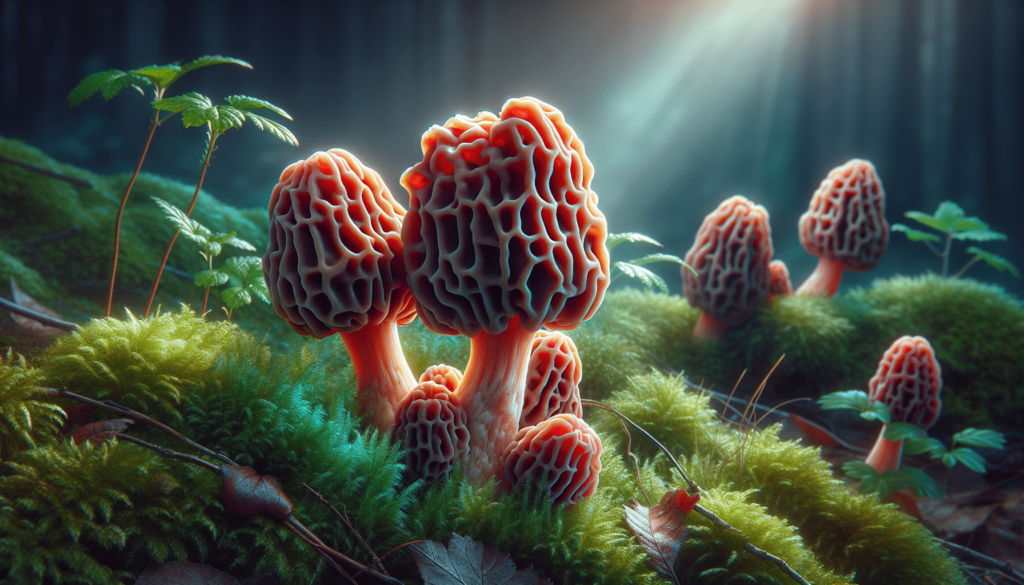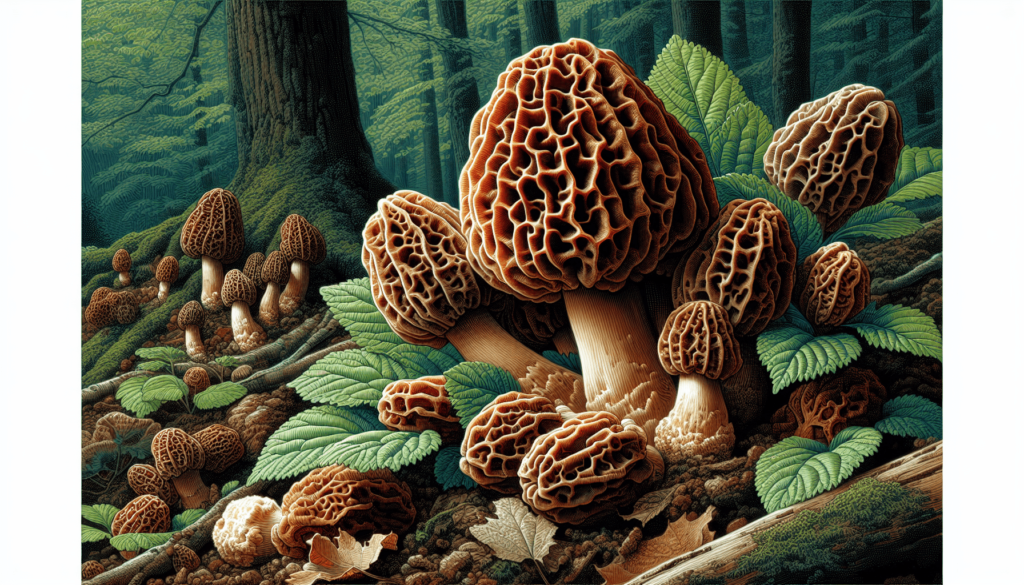You may have come across the term “false morel mushrooms” and wondered if they pose any dangers. Well, worry not, because this article will address your concerns and shed light on the topic. We will explore the essential aspects of false morel mushrooms, their potential toxicity, and provide you with valuable insights to help you stay safe while enjoying the wonders of the fungal kingdom. So sit back, relax, and let’s delve into the fascinating world of false morel mushrooms!

Introduction
Overview of false morel mushrooms
False morel mushrooms are a group of fungi that resemble the highly sought-after true morel mushrooms. While true morels are prized for their culinary value and are enjoyed by foragers around the world, false morels pose a significant risk to those who consume them. False morels belong to various genera, including Gyromitra and Verpa, and can be found in different regions and habitats.
Identifying False Morels
Physical characteristics
False morels may share some physical characteristics with true morels, but they have distinct features that set them apart. Unlike the well-defined, hollow stem of true morels, false morels have a wavy or brain-like cap that is attached to the stem at the top, forming a saddle shape. The cap can range in color from pale brown to dark reddish-brown, often resembling the appearance of a brain.
Distinguishing true morels from false morels
One of the key differences between true morels and false morels lies in their development. True morels have a distinct honeycomb-like cap that is completely hollow, while false morels have a cotton-like or spongy interior filled with cottony white mycelium. Additionally, true morels have a smooth, conical, or elongated cap shape, while false morels have a wrinkled or convoluted cap surface.
Common species of false morels
Several species of false morels are known to be toxic or potentially toxic, including Gyromitra esculenta, Gyromitra infula, Verpa bohemica, and Verpa conica. These species are often found in forested areas, particularly near decaying organic matter such as fallen logs and wood chips.
Toxicity of False Morels
Chemical compounds present in false morels
False morels contain chemical compounds that can be toxic to humans. The main substance of concern is gyromitrin, which can convert into the toxic compound called monomethylhydrazine (MMH) during digestion. MMH is known to cause liver damage and can be lethal in high doses. Other chemical compounds found in false morels include monomethylhydrazine derivatives, gyromitrin derivatives, and various unidentified compounds.
Symptoms of poisoning
Consuming false morels can lead to a range of symptoms, including nausea, vomiting, abdominal pain, diarrhea, dizziness, headache, and in severe cases, convulsions and coma. The onset of symptoms typically occurs within a few hours to up to 24 hours after consumption. It is essential to seek medical attention immediately if you suspect you have ingested false morels and are experiencing any symptoms.
Severity of poisoning
The severity of false morel poisoning can vary depending on several factors, including the species consumed, the amount ingested, an individual’s sensitivity, and the preparation method. Mild cases of poisoning may cause discomfort and gastrointestinal symptoms that resolve without medical intervention. However, severe cases can lead to acute liver failure and, in rare instances, even death.
Factors influencing toxicity
The toxicity of false morels can be influenced by various factors. The amount of gyromitrin present in the mushroom, as well as individual variations in liver metabolism, can significantly impact the level of toxicity. Additionally, the cooking method used and the length of cooking time can affect the concentration of toxins in the mushrooms. It is important to note that even properly cooked false morels may still contain low levels of toxins.
Types of Poisonous False Morels
Gyromitra esculenta
Gyromitra esculenta, also known as the brain mushroom or the beefsteak morel, is one of the most well-known and potentially toxic false morel species. It is found in various parts of North America, Europe, and Asia. This species contains high levels of gyromitrin and is considered highly poisonous, often leading to severe poisoning symptoms.
Gyromitra infula
Gyromitra infula, commonly known as the hooded false morel, is another species that should be approached with caution. Its cap shape resembles the traditional hood of a monk, hence the name. This species is found in North America and Europe and contains gyromitrin, posing a potential health risk if consumed.
Verpa bohemica
Verpa bohemica, also called the wrinkled thimble cap, is a false morel species that shares similarities with true morels in appearance. It can be found in North America and Europe and is known to contain gyromitrin derivatives. While it is generally considered less toxic than other false morels, caution should still be exercised when consuming Verpa bohemica.
Verpa conica
Verpa conica, or the cone morel, is often mistaken for true morels due to its cone-shaped cap. It is found in Europe and North America and contains gyromitrin and gyromitrin derivatives. Although reports on the toxicity of this species vary, it is generally advised to avoid consuming Verpa conica.
Other potentially toxic false morels
In addition to the aforementioned species, other false morel mushrooms may also contain toxic compounds. It is crucial to exercise caution and consult reputable sources or experts before consuming any unidentified mushrooms.

Culinary Use and Safety
Traditional methods of preparation
In some cultures, false morels have been traditionally consumed after undergoing specific preparation methods to reduce their toxicity. These methods often involve parboiling, drying, and repeated washing to remove toxins from the mushrooms. However, it is important to note that even with these traditional techniques, false morels may still pose a danger to health and should be approached with caution.
Cautions and warnings
Due to the potential toxicity of false morels, it is generally advised to avoid consuming them, especially foragers who are inexperienced or unable to confidently distinguish true morels from false morels. It is crucial to rely on reliable field guides, expert advice, or organized forays to ensure safe and responsible foraging practices.
Cooking to reduce toxicity
Cooking false morels may help reduce their toxicity but does not eliminate the risk entirely. High temperatures, such as boiling or sautéing, can break down some of the toxins present. However, it is crucial to note that toxins can still be present in cooked false morels, and low and slow cooking methods may not sufficiently reduce toxicity. Consulting with experts or mycologists is always recommended to ensure safe consumption.
Regulations and Guidelines
Legal status of false morels
The legal status of false morels varies depending on the country and region. In some areas, it is completely prohibited to sell or distribute false morels due to their potential toxicity. It is important to familiarize yourself with local regulations and guidelines regarding the collection, sale, and consumption of wild mushrooms to ensure compliance with the law.
Food safety recommendations
Food safety authorities often advise against the consumption of false morels due to their potential toxicity. It is important to follow these recommendations and exercise caution when encountering wild mushrooms, especially if you are uncertain about their identification.
Guidance for foraging and consumption
Foragers and mushroom enthusiasts are encouraged to seek guidance from experienced mycologists, mushroom clubs, or reputable sources before engaging in wild mushroom foraging. These experts can provide valuable information about safe identification, collection, and consumption practices for true morels and other edible mushrooms. It is essential to prioritize safety and responsible foraging to avoid the risk of poisoning.
Research and Studies
Toxicological studies on false morels
Several studies have been conducted to better understand the toxicity and chemical composition of false morels. These studies have identified the presence of gyromitrin and its derivatives in various false morel species. The research aims to raise awareness about the potential risks associated with false morel consumption.
Effect of cooking on toxins
Studies have also explored the effect of cooking on reducing the toxicity of false morels. While cooking does break down some toxins, it may not be completely effective in eliminating them. Researchers continue to investigate optimal cooking methods and conditions to minimize the risks associated with false morel consumption.
Risk assessment for consumption
Due to the potential health risks associated with false morels, risk assessment studies have been conducted to evaluate safe consumption levels. These studies consider factors such as toxin content, cooking methods, and individual susceptibility. The findings aid in establishing guidelines and recommendations for safe consumption practices.
Real-Life Poisoning Cases
Reported incidents of false morel poisoning
Across different countries, there have been numerous reported cases of false morel poisoning. These incidents often occur due to misidentification, lack of knowledge, or improper cooking techniques. False morel poisoning cases serve as a reminder of the importance of cautious foraging and responsible consumption.
Symptoms, treatment, and outcomes
False morel poisoning can cause a range of symptoms, as mentioned earlier, from gastrointestinal issues to severe neurological effects. Treatment may include gastrointestinal decontamination, liver support, and symptomatic management. Prognosis and outcomes vary depending on the severity of poisoning and prompt medical intervention.
Lessons learned
Real-life poisoning cases provide valuable lessons for foragers and mushroom enthusiasts. These incidents highlight the significance of accurate identification, cautious foraging practices, proper cooking techniques, and seeking professional advice when uncertain.
Prevention and Safety Measures
Tips for safe mushroom foraging
To ensure safe mushroom foraging, follow these tips:
- Educate yourself about different species and their identification characteristics.
- Consult experienced mycologists or join mushroom clubs to deepen your knowledge.
- Use reliable field guides and reputable sources to aid in identification.
- Avoid picking mushrooms in polluted areas or areas treated with chemicals.
- Be cautious when consuming wild mushrooms, especially if you are unfamiliar with them or uncertain about their identity.
Precautions while handling false morels
When handling false morels, take the following precautions:
- Wear gloves to avoid direct contact with the mushrooms.
- Wash your hands thoroughly after handling false morels.
- Do not allow children or pets to handle or consume unidentified mushrooms.
- Store mushrooms separately to prevent accidental consumption.
Training and education
To ensure safe foraging practices, consider the following:
- Participate in forays or workshops conducted by experienced mycologists.
- Attend mushroom identification classes or seminars.
- Read books and articles by reputable experts.
- Regularly update knowledge and stay informed about new research findings.
Conclusion
Summary of key points
False morel mushrooms, despite their resemblance to true morels, pose a significant risk due to their potential toxicity. Gyromitra and Verpa species are among the common false morels that can cause poisoning symptoms. The chemical compounds present in false morels, such as gyromitrin, can be toxic to humans and may cause various health issues, ranging from gastrointestinal discomfort to severe liver damage. Though traditional preparation methods and cooking can reduce the toxicity to some extent, the risk of poisoning remains. It is important to follow legal guidelines, food safety recommendations, and consult experts before foraging or consuming wild mushrooms.
Importance of cautious foraging
Cautious foraging is of utmost importance when it comes to false morel mushrooms. Accurate identification, thorough knowledge, and responsible practices are essential to minimize the risk of poisoning. By prioritizing safety measures, seeking guidance from experts, and continuously educating ourselves, we can enjoy the wonders of the natural world while ensuring our well-being. Remember, when it comes to wild mushrooms, it’s better to be safe than sorry.



No Responses